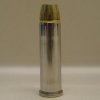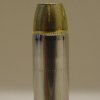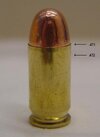I agree with 'rcmodel,' (and possibly others, naturally). The trick is enough crimp, without working the neck brass so much that you get premature cracking. I load .38 Spl (the example given) to moderate velocities with a 158 gr. Rainer plated bullet, and shoot them in revolvers only. Given that, I'm belling the case (using the expander on a Dillon 650) around .004" (that's four thousandths), which is plenty large to avoid shaving the plating. I, too, use the Lee FCD in station 5, and following the included directions (I know, it's not very manly of me, but, oh well....) I bottomed out the die on the shell plate (necessary for the post-sizing operation), backed out the crimp apparatus, ran a case all the way up and screwed the crimper down until it just touched the case mouth. Then, when I loaded a round, I tightened the crimper 1/2 turn and checked:
1. The cartridge drops into the case gauge & the cylinder of my revolver.
2. I cannot budge the bullet with my thumb or by pressing with moderate force on the bench.
3. I conclude that this is enough crimp for these loads.
When I'm loading .45 Colt, I put a crimp more like "C" in the illustration in the OP, because there's a lot more inertia in the 250 gr. bullet to cause setback, and, more importantly, I shoot some of the .45 LC in a rifle with a tubular magazine that holds 13 rds., and I don't want those bullets moving in the magazine by a combination of spring pressure and recoil energy.
NB: For those who may be new to all this, when NOT using a separate crimp die like the Lee, i.e., you're using the standard seat/crimp die that comes with the majority of die sets, getting the die set to seat AND crimp is tricker, because you must allow some "windage" when adjusting the seating, and seat the bullet a bit further out to start. Then, when you crank the die down for the crimp, since you are simultaneously seating the bullet deeper it will come out right.















